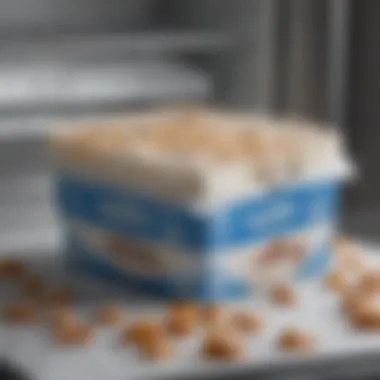Exploring the Viability of Freezing Half and Half


Intro
Half and half is a popular dairy ingredient used in various culinary applications, from coffee to creamy sauces. However, there is often a question regarding its long-term storage: can half and half be frozen without losing its essential qualities? Understanding this topic encompasses not only the practicality of freezing half and half but also the science behind freezing dairy products.
In this article, we will explore the viability of freezing half and half, discussing both the benefits and challenges associated with this method. We will delve into the impact of freezing on the texture and flavor of half and half and provide practical guidance on how to properly freeze and thaw this versatile ingredient.
Additionally, we will uncover culinary applications for frozen half and half, catering to food lovers of all ages. By the end of this article, you should have a comprehensive understanding of how to maximize the usage of half and half in your kitchen while maintaining its quality.
Prelims
Understanding the viability of freezing half and half is important for those who frequently use this dairy product. Many people find themselves with an excess of half and half and may wonder if freezing it is a practical solution. This article aims to explore the intricacies of freezing half and half, highlighting benefits, disadvantages, and best practices for storing this versatile ingredient.
Freezing can extend the shelf life of dairy products, which can be very handy. By learning about this process, users can avoid waste and make cost-effective choices in their cooking or baking endeavors. However, it is also vital to consider the effects that freezing may have on texture and flavor. This article will address these considerations thoroughly.
What is Half and Half?
Half and half is a dairy product made by combining equal parts of milk and cream. It is typically used as a coffee creamer or a substitute for milk in various recipes. The balance of cream and milk gives it a rich, velvety texture, making it a popular choice among culinary enthusiasts.
The cream content in half and half usually ranges from 10.5% to 18%, providing a delightful mouthfeel with lower fat content compared to heavy cream. For many, it serves as an ideal ingredient, complementing a wide array of dishes without overpowering other flavors.
Common Uses of Half and Half
Half and half has diverse applications in the kitchen. Here are some of the key uses:
- As a Coffee Creamer: A common use for half and half is as a creamer for coffee, offering a creamy texture without being overly rich.
- In Cooking: It is often used in sauces and soups, providing a smooth and rich consistency.
- In Baking: Half and half can be incorporated into various baked goods such as cakes, muffins, and custards, enhancing moisture and flavor.
- In Desserts: Many desserts utilize half and half for creamy layers, such as in ice cream or pudding.
The versatility of half and half makes it a staple in many kitchens, allowing culinary enthusiasts to experiment and create delightful dishes. Understanding its potential uses reinforces the relevance of this discussion about storing and freezing half and half.
The Freezing Process
The freezing process is crucial to understand when considering whether to freeze half and half. Proper freezing techniques can impact the quality and usability of this dairy product. Half and half is a versatile ingredient popular in various culinary applications. Knowing how to freeze it without compromising its properties ensures optimal usage in cooking, baking, and beverages.
Understanding Dairy Freezing
Freezing dairy products involves several scientific principles. Dairy contains water, fat, and proteins. When you freeze these products, both the temperature and the composition of the dairy disrupt normal states. Ice crystals form within the liquid, affecting texture and mouthfeel.
When done correctly, the freezing process can preserve half and half for extended periods. However, if the freezing is rapid, larger ice crystals form. This can lead to a grainy or separated texture upon thawing. The aim is to freeze slowly to limit ice crystal size, which is more effective when using a home freezer.
Chemical Composition of Half and Half
Half and half is a blend of equal parts whole milk and heavy cream. This unique composition gives it a smooth and creamy texture, combining the properties of both components. The balance of fat and water is essential in determining half and half's freezing capabilities.
- Fat Content: The fat in cream helps maintain some creaminess after freezing, while the milk component provides liquidity. Fat helps to stabilize emulsions, but when frozen, it can also separate from the liquid.
- Water and Proteins: Water, when frozen, pushes the proteins to the side, potentially breaking the emulsion. Proteins can also denature, leading to changes in texture.


Understanding these qualities helps in preparing half and half for freezing while minimizing undesirable results.
In summary, knowing the chemistry involved in freezing half and half provides insight into how to maintain its quality during storage.
Can You Freeze Half and Half?
The topic of freezing half and half is essential for anyone looking to manage their kitchen resources efficiently. This versatile dairy product is often used in a variety of recipes, but its shelf life can be a limiting factor for some. As such, exploring the feasibility of freezing half and half can reveal numerous benefits as well as certain considerations that need attention.
Benefits of Freezing
One of the key advantages of freezing half and half is reducing waste. Often, half and half comes in larger containers than a recipe requires, leaving the remainder unused. By freezing this excess, you can preserve it for future use without compromising its quality significantly.
Additionally, freezing allows for convenience. Many people buy half and half for specific recipes, yet they may find themselves not using it all before it spoils. If you frequently incorporate half and half into your cooking or baking, freezing can ensure you always have some on hand. The preparation for freezing is simple:
- Useful for Baking: Many baking recipes call for half and half. By having frozen half and half available, you can avoid last-minute trips to the grocery store.
- Versatile for Cooking: It can be added to soups and sauces, enhancing creaminess even when previously frozen.
- Cost-Effective: Buying half and half in bulk and freezing the extra can save money in the long run.
Being able to grab a container from the freezer saves time, especially for home cooks who juggle multiple ingredients and strategies in the kitchen.
Drawbacks of Freezing
However, not all is straightforward when freezing half and half. Understanding the drawbacks is just as important as acknowledging the benefits. One original concern relates to the texture and consistency post-thawing. While freezing can preserve flavor, the emulsion of fat and water within half and half may separate, leading to a grainy texture after thawing. This can affect how it performs in recipes requiring a smooth consistency.
Some factors to consider include:
- Separation: After thawing, users may notice a separation that can be challenging to reintegrate. Churning or whisking may help, but it may not fully restore the original consistency.
- Limited Storage Duration: Although frozen half and half can last for several months, its quality can diminish over time, impacting flavor.
- Impacted Flavor: While many ingredients freeze well, some dairy products can undergo minor flavor changes, affecting the outcome in delicate dishes.
Evaluating these pros and cons will help home cooks determine if the practice aligns with their culinary goals. Ultimately, understanding can guide a more informed decision on whether to freeze half and half.
Best Practices for Freezing Half and Half
When it comes to freezing half and half, proper techniques can make a significant difference in the quality and usability of the product once thawed. Following best practices ensures that the half and half does not suffer from texture or flavor degradation. The right approach helps to retain its creaminess, making it suitable for various culinary applications even after freezing.
Choosing the Right Container
Selecting appropriate containers is crucial for preserving the quality of frozen half and half. Containers should be constructed from materials that withstand the freezing process. Glass jars, plastic freezer bags, and airtight plastic containers are popular options. Important features to consider include:
- Size: Choose containers that fit your needs, balancing space and quantity. Smaller portions are easier to thaw without waste.
- Sealability: Ensure containers are airtight to prevent freezer burn. Contaminated air can lead to unpleasant flavors and compromised texture.
- Freezer-safe: Look for products labeled as freezer-friendly. This will help avoid cracks or leaks during the freezing process.
Preparing Half and Half for Freezing
Preparation is essential before freezing half and half. It’s best to take a few precautions to optimize the freezing process:
- Portion Appropriately: Divide half and half into smaller portions, since this allows for easy thawing without handling excess.
- Avoid Overfilling: Leave some space in the containers. Liquids expand when frozen, and this expansion can lead to spills.
- Inspection: Before freezing, ensure that the half and half is fresh and free from any signs of spoilage. Using quality ingredients is vital to achieving the best results post-thaw.
Labeling and Storing


Proper labeling and systematic storage can greatly aid in the efficient use of frozen half and half. Consider the following steps:
- Label Clearly: Indicate the date of freezing and the contents on each container. This aids in tracking freshness.
- Storage Conditions: Place the labeled containers in the coldest part of your freezer. This slows down any potential adverse changes in texture or flavor.
- Organized Storage: Keep similar items together. This reduces the time spent searching and limits the exposure of the half and half to warmer air when retrieving it.
Following these best practices can significantly improve the quality of half and half when frozen. Close attention to detail ensures you can enjoy this versatile product without compromising its original characteristics.
Thawing and Reusing Frozen Half and Half
Thawing and reusing frozen half and half is a critical aspect of maximizing its usability in the kitchen. This section aims to explore the nuances of thawing frozen half and half effectively while ensuring that quality is not compromised. Understanding proper thawing techniques can significantly impact the texture and flavor of half and half in subsequent culinary applications.
Thawing Methods
There are multiple methods for safely thawing frozen half and half. Each method varies in speed and suitability, depending on when it is required in the kitchen. Here are some common approaches:
- Refrigerator Thawing: The best method for thawing half and half is placing it in the refrigerator. This process could take several hours or overnight, making it ideal for planning meals in advance. It allows for gentle thawing, which helps preserve the texture and flavor.
- Cold Water Thawing: For quicker use, submerging the sealed container in cold water can be effective. This method should take about 30 minutes to an hour. Change the water occasionally to maintain a cold temperature, ensuring safe thawing.
- Microwave Thawing: This method is the fastest, taking only a few minutes. However, it comes with risks. Microwaving can lead to uneven thawing, causing portions to heat and others to remain frozen. If not monitored closely, this method may also alter the texture, creating a grainy consistency.
It is essential to avoid thawing half and half at room temperature, as this could lead to bacterial growth and compromise safety.
Assessing Quality Post-Thaw
After thawing, assessing the quality of half and half is important to ensure it is suitable for use. Here are key indicators to consider:
- Texture: Upon thawing, half and half may separate. This is typical due to the emulsion breaking down during freezing. Gently stir it to restore a smoother texture. If it remains grainy or curdled, it may not be usable.
- Smell: Fresh half and half should have a light, creamy aroma. If there are off odors or sour notes, it is best to discard it. This indicates spoilage or quality degradation.
- Color: The color should remain consistent with its original state – a pale cream shade. Any noticeable change may suggest it has been compromised.
- Taste Test: If all visual and olfactory cues are normal, proceed with a small taste test. If the flavor is off, it's advisable not to use it in any recipes.
When thawing frozen half and half, maintaining quality is as crucial as the thawing method chosen. Thorough assessments ensure that culinary applications achieve desired results.
By employing appropriate thawing methods and assessing quality after thawing, food lovers can effectively incorporate frozen half and half back into their cooking and baking endeavors. The key lies in understanding that even though freezing can alter certain elements, careful handling can maintain the integrity needed for successful culinary use.
Culinary Applications of Frozen Half and Half
The significance of understanding the culinary applications of frozen half and half cannot be understated. As more people seek to minimize waste in their kitchens, utilizing frozen half and half effectively becomes essential. Not only does it extend the shelf life of this valuable dairy product, but it also opens new avenues for its use in various dishes. This section will delve into how frozen half and half can be integrated into cooking, baking, and beverages, ensuring that food lovers can harness its full potential without compromising on quality.
In Cooking
In cooking, frozen half and half serves numerous purposes. It can enrich sauces, soups, and casseroles with a creamy texture without the risk of spoilage. When used in savory dishes, thawed half and half can replace regular cream or milk, providing a smoother consistency and a depth of flavor.
To use, thaw the half and half in the refrigerator or using a quick method in warm water. Once thawed, it can be gently whisked back to its original state, making it suitable for various applications. Note that separation may occur after freezing, but this is manageable with a good stir. Incorporating frozen half and half into recipes can enhance richness in dishes such as:
- Creamy Pasta Sauces
- Potato and Vegetable Soups
- Savory Scones and Biscuits
These examples emphasize the utility of frozen half and half in daily cooking.
In Baking
Baking with frozen half and half offers distinct benefits. It can replace milk or cream in recipes, particularly in doughs and batters. The resulting treats often come out moist with a delicate crumb, allowing baked goods to stay fresh longer.


To utilize, simply incorporate the thawed half and half as indicated in the recipe. It is ideal for:
- Pancakes and Waffles
- Muffins and Quick Bread
- Custards and Puddings
Bakers might find that frozen half and half adds a pleasing richness and flavor profile that elevates ordinary recipes.
In Beverages
When it comes to beverages, frozen half and half can transform a simple drink into an indulgent experience. Its creamy consistency makes it a perfect addition to coffees, teas, and smoothies. For those who enjoy a rich coffee experience, adding thawed half and half can create a velvety texture in lattes or cold brews.
Additionally, it serves well in:
- Milkshakes
- Frozen Hot Chocolate
- Creamy Smoothies
These applications highlight how versatile frozen half and half can be in drink preparations, appealing to those who savor the rich mouthfeel in their beverages.
"Frozen half and half is not just a kitchen shortcut; it is a smart way to enhance flavor and texture across multiple culinary applications."
Alternatives to Freezing Half and Half
Exploring alternatives to freezing half and half is crucial for ensuring that culinary needs are met without compromising the quality of the product. Freezing can change the texture and flavor of half and half, which may not be suitable for every recipe or individual preference. Therefore, understanding different options can help in maintaining the desired characteristics of this dairy product. This section will delve into shelf-stable alternatives and effective refrigerator storage techniques.
Shelf-stable Alternatives
Shelf-stable alternatives to half and half offer convenience, especially for those who may not want to freeze their dairy products. These alternatives maintain stability at room temperature, providing versatility in both cooking and baking. Common options include:
- Powdered Creamers: These are dry forms of cream and are used in coffee or recipes requiring dairy. They can be reconstituted with water and mimic the texture of half and half.
- Non-Dairy Creamers: These products, derived from plant-based sources such as almond or coconut, can serve as substitutes. They often provide a similar creamy texture without the need for refrigeration.
- Evaporated Milk: With its thicker consistency, evaporated milk can be used in various dishes. It adds creaminess without the need for freezing and is often a pantry staple.
- Condensed Milk: This sweet alternative can be a replacement in recipes requiring sweetness along with creaminess. However, it is important to note that it may alter the flavor profile of the original recipe.
- Whole Milk and Heavy Cream Mixture: Mixing equal parts of whole milk and heavy cream can serve as a close approximation to half and half, suitable for hand-crafted beverages and sauces.
These alternatives ensure that the smooth texture and creaminess sought in recipes can still be achieved without the need for freezing, making it easier for users to manage inventories effectively.
Refrigerator Storage Tips
Proper storage in the refrigerator can extend the freshness of half and half and reduce waste. Consider the following tips to maximize its shelf life effectively:
- Seal Properly: Ensure that the half and half is kept in an airtight container after opening. This helps to prevent exposure to air, which may cause spoilage.
- Keep Temperature Consistent: Store half and half at a consistent temperature, ideally at or below 40°F (4°C), and avoid placing it in the fridge door where temperatures fluctuate.
- Use by Date: Always adhere to the expiration date printed on the packaging. While half and half may still be good for a short period after this date, quality can degrade over time.
- Monitor for Changes: Regularly check for changes in odor or texture. If the half and half begins to separate or curdle, it is best to discard it.
- Small Portions: Consider dividing the half and half into smaller containers if you frequently use it in recipes. This practice can limit exposure to air and light, contributing to longer freshness.
Adhering to these storage guidelines enhances the potential of half and half and reduces the likelihood of freezer-related drawbacks. With alternatives and proper storage techniques, cooks can seamlessly navigate the challenges posed by freezing dairy products and ensure that they always have the necessary ingredients on hand.
Keeping half and half fresh in the refrigerator allows for instant use in recipes, making cooking much simpler for any enthusiast.
Closure
The conclusion serves as a vital component of this article, encapsulating the exploration of freezing half and half. As we delve into this topic, it becomes evident that understanding the implications of freezing is key for any food enthusiast. The act of freezing half and half can both extend its shelf life and offer convenience in cooking and baking. However, this practice also introduces considerations related to texture and taste.
Highlighting key elements of freezing half and half, it is essential to acknowledge the balance between benefits and drawbacks. On one hand, the practicality of having frozen half and half on hand can reduce waste and ensure that this versatile ingredient is always available. On the other hand, users must be mindful of how freezing affects its composition, particularly regarding separation and changes in creaminess.
Moreover, examining alternative storage solutions strengthens the article's insights. Whether one chooses to freeze half and half or opt for shelf-stable alternatives, the goal remains the same: to maximize the quality and utility of this ingredient.
Key Takeaways
- Freezing half and half can be an effective method for preserving its usability.
- The process may alter texture and flavor, making thawing practices essential.
- There are various culinary applications for frozen half and half.
- It’s vital to be aware of storage tips and alternatives for optimal quality.







